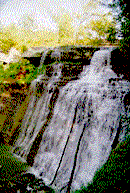Cuyahogan Geology

Cuyahoga Jones not responsible for ad content.

The river twists and turns through its length, well-deserving the name "Cuyahoga (Crooked River)" bestowed on it by Native Americans. The river begins about 30 miles east of Cleveland and takes a generally U-shaped course along the base of an escarpment just north of Akron. The southern segment of the U flows east-to-west, reflecting the tectonic activity which has raised the Appalachian mountains to the east of the region. The western segment of the river flows northward, eventually bisecting Cleveland before discharging into Lake Erie.
Tributaries of the Cuyahoga River include Big Creek, Mill Creek, and Tinkers Creek. Each of these have their own unique qualities and recreational opportunities.
The bedrock underlying the Cuyahoga River Valley consists of shale formed from sediments beneath an ancient ocean which covered the eastern part of the North American continent during the Devonian period millions of years ago. Fossils from this period can be found by separating layers of the ancient shale which have been exposed over thousands of years by the eroding effect of the river. Fossils include many different life forms from microscopic organisms to plants to giant sharks.
Above the bedrock lies glacial till, consisting mainly of silt and clay, generally less than 50 feet thick. The valley floor also contains glacial and river outwash deposits, mainly sand and gravel. These deposits are up to 200 feet thick in some of the Cuyahoga's tributary valleys.
On the surface, the Cuyahoga River Valley consists of river floodplain, steep and gentle valley walls, deciduous and evergreen woods, numerous tributaries, ravines, and upland plateaus. The topsoil of the valley floor's flood-plain is particularly productive for the area's farmers. The gentler slopes of the valley walls make excellent orchards. Deep forests, rolling hills, and open farmlands frame the river valley.
A typical visitor to the Cuyahoga River Valley would likely encounter a multitude of wildlife species, including deer, raccoons, squirrels, chipmunks, and birds too numerous to mention, including several species of waterfowl. The famous buzzards (turkey vultures) which return to Hinckley every March also deserve mention here.
Fishing opportunities abound. Prized species include bass, salmon, trout, walleye, perch, northern pike, and catfish. Favorites for children include carp, sheephead, and many types of panfish. The Great Lakes sturgeon has not been caught on the inland waterways for several years. The infamous Loch Erie monster has never been sighted inland, much to the relief of river fishermen.
The more adventurous visitor may also find turtles, frogs, migratory
salamanders, skunks, beavers, fox, opossums, porcupines, and
coyotes. Escaped farm animals account for the occasional cow,
horse, goat, and chicken sightings. Extraterrestrial life sightings
cannot be confirmed here, as Cuyahoga Jones secretly works as
Earth's ambassador to these friendly and curious beings.
--Cuyahoga Jones
Home |
Temple of Moon |
Raiders of The Lost Pants |
History |
Quotes|
 Kingdom of The Crystal Balls
Kingdom of The Crystal Balls